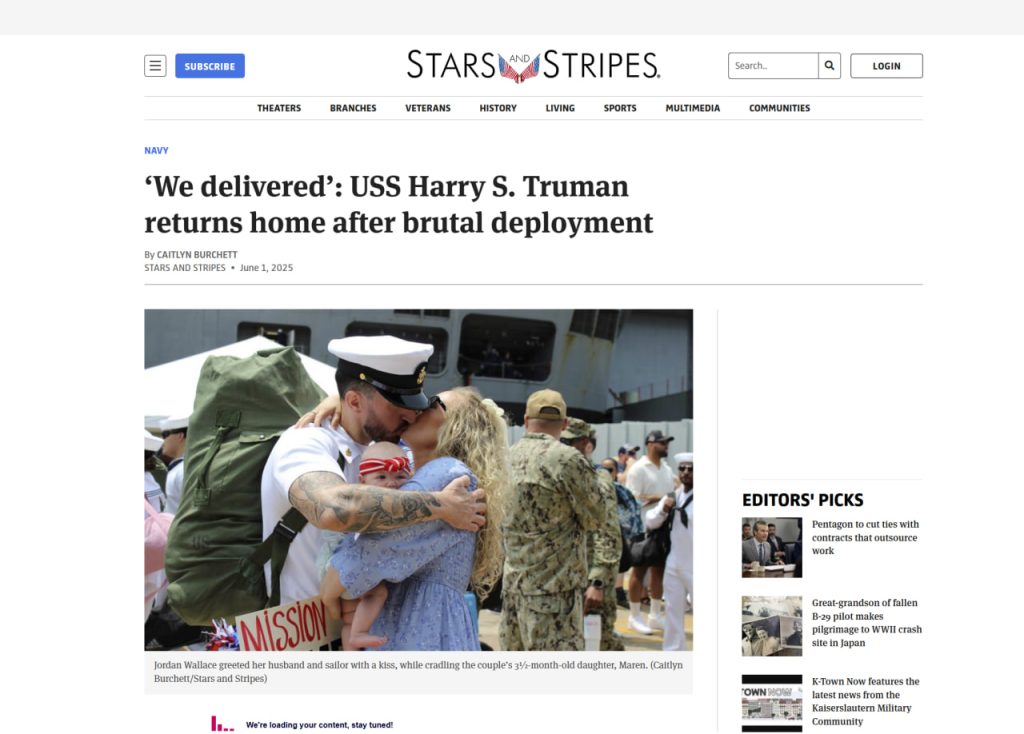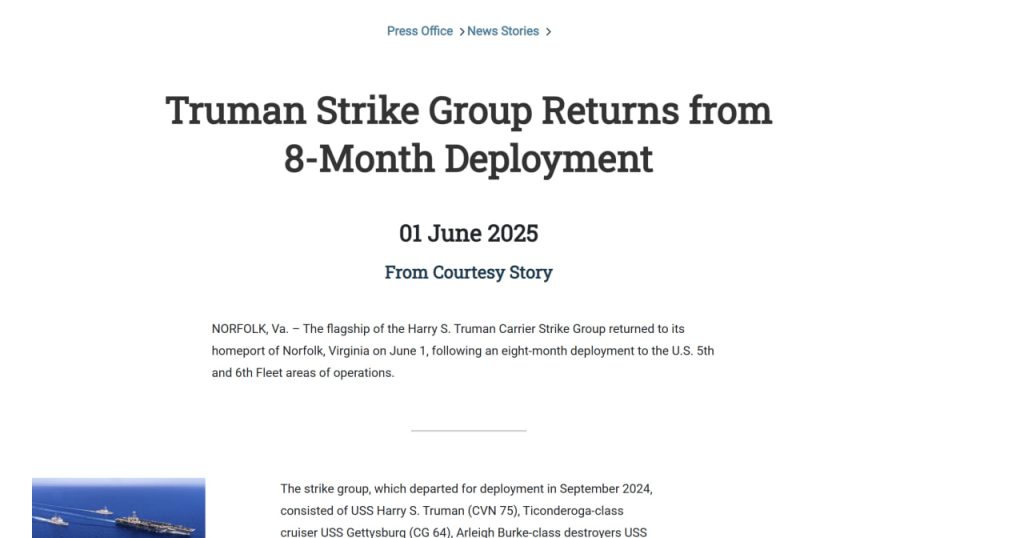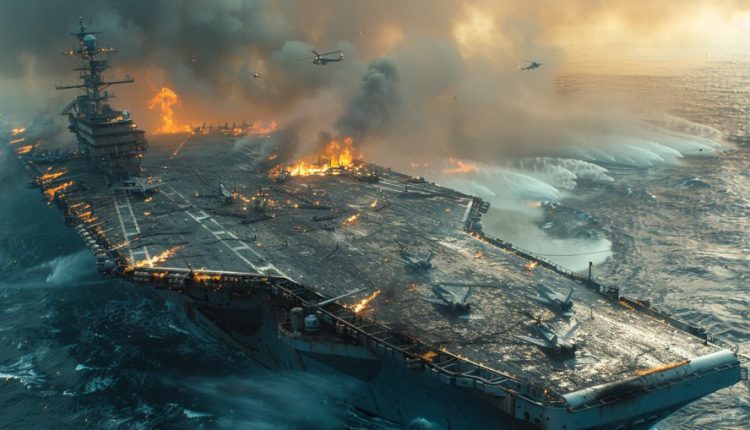“Harry S. Truman”… The Returning Storm Laden with Red Sea Setbacks
The U.S. aircraft carrier Harry S. Truman has returned to its home port in Norfolk, Virginia, burdened with significant material and operational losses after what has been described as one of the most intense and combat-heavy deployments for the U.S. Navy in recent decades. Despite repeated attempts by the U.S. media to portray a “victorious homecoming,” the visible damage to the ship’s hull and the aftermath of a prolonged engagement in the Red Sea tell a very different story.
Truman Returns to Port… Carrying Cracks and Failures
According to the U.S. outlet Stars and Stripes, the Truman came back with notable damage to its external hull, including cracks caused by a collision with a cargo vessel during operations. Moreover, the carrier lost three F/A-18 fighter jets—each valued at approximately $67 million—underscoring the steep cost of this failed American naval deployment in the Red Sea region.
These material losses were compounded by a blow to morale within the U.S. Navy itself, which, under mounting pressure, took the rare step of relieving the carrier’s commanding officer—a decision that reflects the severity of the mission’s shortcomings.

Yemen Sets New Equations… U.S. Carrier Under Fire for Over 50 Days
Despite repeated assurances from U.S. Navy leadership about their “highest readiness,” American media reports revealed that the Truman endured unprecedented resistance in the Red Sea. The carrier was subjected to more than 50 days of continuous air and missile strikes by Yemeni Armed Forces, yet failed to break the momentum of those assaults or neutralize the missile and drone capabilities that targeted both American and Israeli ships in the Red Sea.
In reality, the confrontation was not simply framed as an anti-terror operation, as Washington claimed, but was a direct clash with Yemeni forces that, despite their limited resources, succeeded in posing a strategic challenge to one of the most powerful carriers in the world.

“Truman” Fires Over a Million Pounds of Munitions… But to No Avail
Stars and Stripes reported that throughout the Truman’s mission, the U.S. Navy expended more than 1.1 million pounds of ordnance—125,000 pounds of which were dropped on alleged ISIS positions in Somalia. Yet the outcome was starkly counterproductive: field losses, command confusion, and a glaring demonstration that massive firepower alone could neither resolve the confrontation nor establish even temporary tactical control.
The operation’s drain extended beyond the purely military realm, affecting morale and organizational cohesion. Over the course of 251 days at sea—covering more than 24,000 nautical miles—the Truman failed to stem Yemen’s relentless attacks or secure vital maritime routes for the U.S. and Israel.
U.S. Navy Admits: “We Haven’t Faced a Challenge Like This in Decades”
In a related development, the U.S. Naval Institute released a report characterizing the Truman’s deployment as “the most intense combat operation in decades”—a striking admission rarely heard in official American discourse and an implicit acknowledgment that the mission did not meet its objectives.
The report relayed poignant testimony from field commanders, including the captain of the accompanying destroyer USS Stout, who admitted: “It’s the first time in my life that I’ve seen real combat.” Such statements underscore a shift from the U.S. Navy’s historically demonstrative showing of force to an unplanned, genuine engagement—especially against an adversary with considerable combat experience despite stark disparities in armament.
Rear Admiral Sean Bailey, commander of the Carrier Strike Group, described the mission as “an unprecedented experience,” noting the immense operational and psychological strain it entailed, and conceding that the deployment far exceeded all U.S. leadership’s expectations regarding the nature of the threats encountered.
American Combat Readiness Erodes Under Strain
The report concluded with a strategic warning from Admiral Daryl Caudle, head of U.S. Fleet Forces, cautioning that a prolonged deployment like the Truman’s exacts disproportionate costs on the U.S. military structure: “It erodes readiness, strains families, and degrades operational sustainability, potentially jeopardizing fleet effectiveness in the long run.”
This admission, coupled with the announcement that the carrier will undergo a “full maintenance and refueling” period—a process expected to take years—illustrates the severe wear and tear inflicted on the Truman in waters that were not considered a security concern years ago.
Yemen Redraws the U.S. Navy’s Maritime Power Landscape
This failure unfolds within a regional context marked by fundamental shifts in naval engagement rules. American carriers no longer automatically project an aura of invincibility; instead, they have become direct targets for attacks driven by the will of resistance forces—led foremost by Yemen, which has once again demonstrated its ability to disrupt U.S. and Israeli plans even while under blockade.
It has become clear that countering “asymmetrical” threats—as U.S. military circles now term them—is no longer feasible with traditional means alone. By virtue of its determined stance, Yemen has created a strategic rupture in the U.S. Navy’s doctrinal framework, which previously relied more on displaying force than confronting it.
End of an Era and the Dawn of Decline?
The battered, exhausted return of the Truman to Norfolk may well symbolize the decline of a period in which the United States reigned supreme over the seas without contest. The undeclared war in the Red Sea has laid bare the truth that the most formidable weapon is no longer sufficient, and that even the largest aircraft carriers are vulnerable when compelled by a besieged people to fight a genuine battle in a merciless environment.

